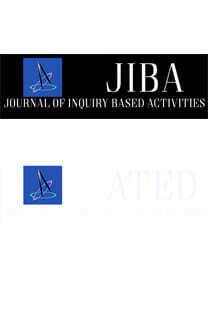STEAM (STEM+SANAT) EĞiTİMİNE YÖNELİK ETKİNLİK UYGULAMASI: AYNALAR VE IŞIK
Bu araştırmada Fen, Teknoloji, Mühendislik ve Matematik [STEM] eğitimine yönelik 5E modeline dayalı bir etkinlik uygulaması gerçekleştirilmiştir. Etkinlik planı 7. sınıf Fen Bilimleri dersindeki “Aynalarda Yansıma ve Işığın Soğrulması” ünitesine yönelik olarak, araştırmacılar tarafından tasarlanmıştır. Araştırma 2017-2018 eğitim-öğretim yılında 30 öğrenciden oluşan bir 7. sınıfta uygulanmıştır. STEAM odaklı 5 etkinlik, 5 hafta (toplamda 20 ders saati) süresinde tamamlanmıştır. Öğrenciler grup çalışmasıyla mühendislik tasarım sürecini uygulayarak etkinlikleri gerçekleştirmişlerdir. Etkinliklerde temel olarak kaleydoskop, yansıtıcı heykel, güneş fırını, spektroskop ve ışık gösterisi aracı tasarımları yapılmıştır. Araştırmada yapılan gözlem ve görüşmeler sonucunda öğrencilerin olabildiğince yaratıcı tasarımlar ortaya çıkardıkları belirlenmiş ve etkinliklerle uğraşmayı sevdiklerine yönelik olumlu sonuçlar elde edilmiştir. Araştırmanın öğretmenlere ve araştırmacılara yönelik, STEAM eğitiminin sınıf uygulaması hakkında somut bir örnek içerdiği düşünülmektedir.
ACTIVITY IMPLEMENTATION INTENDED FOR STEAM (STEM+ART) EDUCATION: MIRRORS AND LIGHT
In this research, an activity based on 5E model for STEAM education was implemented. The activity plan was designed by researchers for the “Reflection in the Mirror and Absorption of Light” in the 7th grade science class. The research was implemented in a 7th grade group of 30 students in 2017-2018 academic year. Five STEAM focused activities were completed over 5 weeks (20 hours in total). The students performed the activities by applying the engineering design process with group work. Kaleidoscope, reflective sculpture, solar oven, spectroscope, and vehicle of light show designs were generated in the activities. As a result of the observations and interviews made in the research, positive results have been obtained that students made creative designs as much as possible and liked to work with the activities. The activities shared in the article are concrete examples of STEAM education in classroom for teachers and researchers.
___
- Allina, B. (2018). The development of STEAM educational policy to promote student creativity and social empowerment. Arts Education Policy Review, 119(2), 77-87. doi:10.1080/10632913.2017.1296392
- Aydeniz, M. (2017). Eğitim sistemimiz ve 21. yüzyıl hayalimiz: 2045 hedeflerine ilerlerken, Türkiye için STEM odaklı ekonomik bir yol haritası. University of Tennessee, Knoxville. http://trace.tennessee.edu/utk_theopubs/17 adresinden erişildi.
- Ayvacı, H. Ş., & Ayaydın, A. (2017). Bilim teknoloji mühendislik sanat ve matematik (STEAM). S. Çepni (Ed.), Kuramdan uygulamaya STEM+A+E eğitimi (ss. 115-130). Ankara: Pegem Akademi.
- Batı, K., Çalışkan, İ., & Yetişir, M. İ. (2017). Fen eğitiminde bilgi işlemsel düşünme ve bütünleştirilmiş alanlar yaklaşımı (STEAM). Pamukkale Üniversitesi Eğitim Fakültesi Dergisi, 41, 91-103.
- Braund, M. (2015). A new STEAM age: Towards one culture for learning science. In M. Pehlivan (Ed.), The Eurasia Proceedings of Educational & Social Sciences: International Conference on Education in Mathematics, Science & Technology (pp. 13-17). Antalya, Turkey: ISRES Publishing.
- Bybee, R. W., Taylor, J. A., Gardner, A., Scotter, P. V., Powell, J. C., Westbrook, A., & Landes, N. (2006). The BSCS 5E instructional model: Origins, effectiveness, and applications. Colorado Springs, CO: BSCS and NIH.
- Cook, K. L., & Bush, S. B. (2018). Design thinking in integrated STEAM learning: Surveying the landscape and exploring exemplars in elementary grades. School Science and Mathematics, 118, 93–103.
- Cunningham, C. M., & Hester, K. (2007). Engineering is elementary: An engineering and technology curriculum for children. Presented at the ASEE Annual Conference and Exposition, Honolulu, HI. Retrieved from https://www.eie.org/sites/default/files/research_article/research_file/ac2007full8.pdf
- Daugherty, M. K. (2013). The prospect of an "A" in STEM education. Journal of STEM Education: Innovations and Research, 14(2), 10-15.
- Doğan, H., Savran Gencer, A., & Bilen, K. (2017). Fen ve mühendislik uygulaması: Yenilebilir ve yenilenebilir araba yarışması etkinliği üzerine bir durum çalışması. Araştırma Temelli Etkinlik Dergisi, 7(2), 62-85. http://www.ated.info.tr/index.php/ated/issue/view/14 adresinden erişildi.
- Gülhan, F. (2016). Fen-teknoloji-mühendislik-matematik entegrasyonunun (STEM) 5. sınıf öğrencilerinin algı, tutum, kavramsal anlama ve bilimsel yaratıcılıklarına etkisi (Yayımlanmamış doktora tezi). Marmara Üniversitesi Eğitim Bilimleri Enstitüsü, İstanbul.
- Gülhan, F., & Şahin, F. (2018). STEAM (STEM+Sanat) etkinliklerinin 7. sınıf öğrencilerinin akademik başarı, STEAM tutum ve bilimsel yaratıcılıklarına etkisi. Journal of Human Sciences, 15(3), 1675-1699. doi:10.14687/jhs.v15i3.5430
- Katehi, L., Pearson, G., & Feder, M. (Eds.). (2009). Engineering in K–12 education: Understanding the status and improving the prospects. National Academy of Engineering and National Research Council. Washington, DC: National Academies Press.
- Milli Eğitim Bakanlığı. (2013). İlköğretim kurumları (ilkokullar ve ortaokullar) fen bilimleri dersi (3, 4, 5, 6, 7 ve 8. sınıflar) öğretim programı. Ankara: Talim ve Terbiye Kurulu Başkanlığı.
- Ozkan, G., & Umdu Topsakal, U. (2017). Examining students‟ opinions about STEAM activities. Journal of Education and Training Studies, 5(9), 116-123.
- Plonczak, I., & Zwirn, S. G. (2015). Understanding the art in science and the science in art through crosscutting concepts. Science Scope, 38(7), 57-63.
- Sanders, M. (2009). STEM, STEM education, STEMmania. The Technology Teacher, 68(4), 20-26.
- Sochacka, N. W., Guyotte, K. W., & Walther, J. (2016). Learning together: A collaborative autoethnographic exploration of STEAM (STEM+theArts) education. Journal of Engineering Education, 105(1), 15-42.
- Sparkes, V. P. (2017). STEAM nedir? İstanbul: Ayrıntı Yayınları.
- Tenaglia, T. (2017). STEAM curriculum: Arts education as an integral part of ınterdisciplinary learning. Messiah College Curriculum and Instruction Research Project, Parkway.
- Topdemir, H. G. (2012). Leonardo da Vinci‟nin optik çalışmaları. Dört Öge, 2, 37-50.
- Tuncel, E. (2017). Ortaokul fen bilimleri 7. sınıf ders kitabı. Ankara: Mevsim Yayıncılık.
- Watson, A. D., & Watson, G. H. (2013). Transitioning STEM to STEAM: Reformation of engineering education. Journal for Quality & Participation, 36(3), 1-4.
- Yakman, G. (2010). What is the point of STE@M?-A Brief Overview. Retrieved from https://steamedu.com/wp-content/uploads/2016/01/What_is_the_Point_of_STEAM_A_Brief_Overv.pdf
- Yıldırım A., & Şimşek H. (2008). Sosyal bilimlerde nitel araştırma yöntemleri (7. Baskı). Ankara: Seçkin Yayıncılık.
- ISSN: 2146-5711
- Yayın Aralığı: Yılda 2 Sayı
- Başlangıç: 2011
- Yayıncı: Evrim Erbilgin
